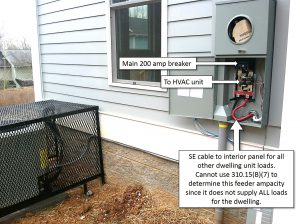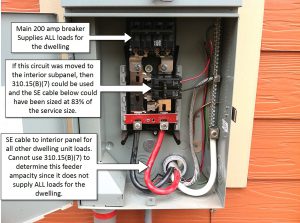Applying NEC 310.15(B)(7)
By: JADE Learning | Nov 26, 2014
NEC Table 310.15(B)(7) has been used for many Code cycles to determine the minimum ampacity of single phase 120/240 volt dwelling unit service and feeder conductors. Most of us are aware by now that in the 2014 NEC, Table 310.15(B)(7) has been removed and replaced with a simple percentage (83%), which when properly applied to the rating of the service, will result in the same size service or feeder conductors that were previously listed in the deleted table.
The fact that the table was removed is neither here nor there. More importantly is how to apply the 83% and when the Code section allows us to use it. Applying 310.15(B)(7) to one-family dwellings or the individual dwelling units of two-family and multi-family dwellings, has always been dependent on a few important factors:
- The service or feeder must be between 100 amps and 400 amps
- The service or feeder conductors must be supplied by a single-phase, 120/240-volt system
- The service or feeder conductors must supply ALL LOADS for the dwelling
 Using a service or feeder conductor that is rated less than the final result of the load calculations has always been based on the idea that the more loads connected to the service, the less likely it is for all the loads to be in operation at the same time (load diversity). Because of this, a smaller service or feeder conductor is permitted to be used.
Using a service or feeder conductor that is rated less than the final result of the load calculations has always been based on the idea that the more loads connected to the service, the less likely it is for all the loads to be in operation at the same time (load diversity). Because of this, a smaller service or feeder conductor is permitted to be used.
If all of the above criteria has been met then we can take the service rating and multiply it by 83% to find out the minimum ampacity required for the service or feeder conductors instead of going straight to Table 310.15(B)(16).
Example: If the load calculations for the dwelling resulted in the need for a 200 amp electric service, then 200 amps X 83% = 166 amps. We just determined that a service conductor would need to be rated for at least 166 amps in order to supply the dwelling. If a 75°C copper conductor and 75°C terminals are used then this will result in a 2/0 AWG service or feeder conductor chosen from Table 310.15(B)(16). If 310.15(B)(7) could not be used because the service or feeder conductors did not supply all dwelling unit loads, then a 3/0 AWG conductor would be required from Table 310.15(B)(16).
A common question about the real world application of this section always seems to come up:
- Question: What about an electric service where there are empty spaces between the main breaker and the feeder conductors to the interior subpanel? Isn’t this an invitation to add more loads after the feeder below was originally calculated at 83% because it used to supply all loads for the dwelling?
- Answer: Ask your local AHJ. Many Inspectors feel that as long as all of the required loads (for a house to be considered habitable per the Building Code) are present at final inspection then it can be approved and the Inspector will make a simple note in the computer that the exterior electric panel had no additional loads present and was therefore code compliant at the time of final approval.
Learn more in the 2014 NEC Changes courses at https://www.jadelearning.com.



would a 120/208V 1-phase service to a residence in a multi-family building also be able to be rated with this?
This section of the NEC only mentions 120/240 volt electrical systems.
The 2017 NEC ART: 310.15 (7) (1) feeders can be no less than 83% it does not say ( SHALL ) they must be large enough to carry the calculated demand